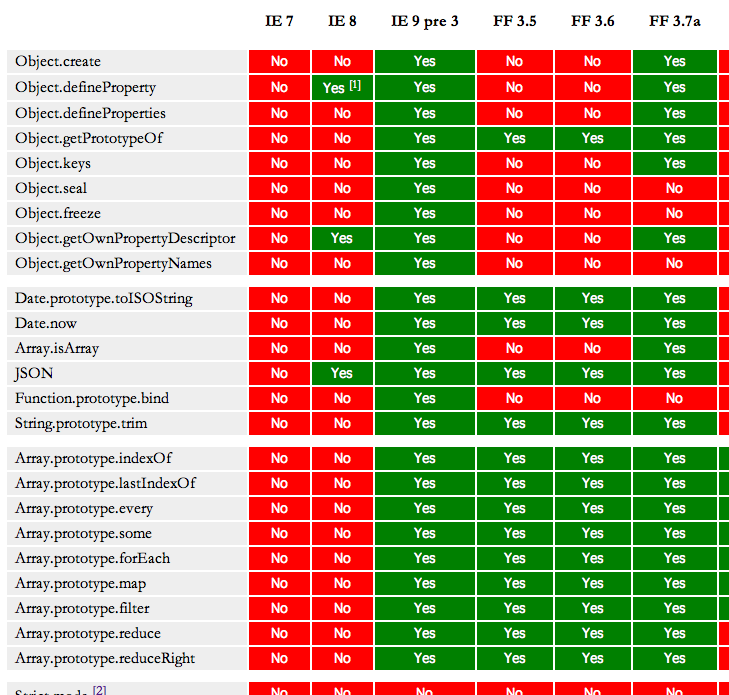JScript and DOM changes in IE9 preview 3
3rd preview of IE9 was released yesterday, with some amazing additions, like canvas element and an extensive ES5 support. I’ve been digging through it a little, to see what has changed and what hasn’t — mainly looking at JScript and DOM. I posted some of the findings on twitter, but want to also list them here, as it’s not very convenient to share code snippets in 140 characters. Referencing it all in one place will hopefully make it easier for IE team to find and fix these deficiencies.
ECMAScript 5 and JScript
The big news is that IE9pre3 has (almost) full support for ES5. By “full support”, I mean that it implements majority of new API, such as Object.create, Object.defineProperty, String.prototype.trim, Array.isArray, Date.now, and many other additions. As of now, IE9 implements the largest number of new methods; even more than latest Chrome, Safari and Firefox. Unbelievable, isn’t it? :)

You can see the results in this compatibility table (note that it lists results of mere “existence” testing, not any kind of conformance).
What's missing is strict mode, which actually isn't implemented in any of the browsers yet.
Some of the things I noticed:
ES5 Object.getPrototypeOf on host objects seems to lie, always returning null instead of proper value of [[Prototype]]:
Object.getPrototypeOf(document.body); // null
Object.getPrototypeOf(document); // null
Object.getPrototypeOf(alert); // null
Object.getPrototypeOf(document.childNodes); // null
This doesn’t happen in other browsers that implement Object.create at the moment, such as latest Chrome, WebKit or Firefox. In Chrome, for example:
Object.getPrototypeOf(document.body) === HTMLBodyElement.prototype;
Object.getPrototypeOf(document) === HTMLDocument.prototype;
Object.getPrototypeOf(alert) === Function.prototype;
Object.getPrototypeOf(document.childNodes) === NodeList.prototype
… and so on.
Interestingly, bound functions in IE9pre3 are represented as “function(){ [native code] }”, similar to host objects:
var bound = (function f(x, y){ return this; }).bind({ x: 1 });
bound + ''; // "function(){ [native code] }"
// compare to
alert + ''; // "function alert(){ [native code] }"
Note how function representation does not include identifier (f), parameters (x and y), nor representation of function body (return this;). This of course proves once again that relying on function decompilation is NOT a good idea.
Whitespace character class (as in /\s/) still doesn’t match majority of whitespace characters (as defined by specs). These include “U+00A0”, “U+2000” to “U+200A”, “U+3000”, etc. The test is available here. Curiously, ES5 String.prototype.trim seems to “understand” those characters as whitespace very well, producing empty string — as expected — for something like '\u00A0'.trim().
It was nice to see that ES5 Array.isArray is about 20 times faster than custom implementation, such as this one:
function isArray(o) {
return Object.prototype.toString.call(o) === "[object Array]";
}
The difference in speed is similar to other browsers that implement this method.
An infamous, 10+ year-old JScript NFE bug, which I described at length before, is finally fixed:
var f = function g() { return f === g; };
typeof g; // "undefined"
f(); // true
arguments’ [[Class]] is now an “Arguments”, just like ES5 specifies it:
var args = (function(){ return arguments; })();
Object.prototype.toString.call(args); // "[object Arguments]"
DOM
Unfortunately, the entire host objects infrastructure still looks very similar to the one from IE8. Host objects don’t inherit from Object.prototype, don’t report proper typeof, and don’t even have basic properties like “length” or “prototype”, which all function objects must have:
alert instanceof Object; // false
typeof alert; // "object"
alert.length; // undefined
Because they don’t inherit from Object.prototype, we don’t have any of Object.prototype methods, naturally:
alert.toString; // undefined
alert.constructor; // undefined
alert.hasOwnProperty; undefined
Object.prototype is not the only object host methods fail to inherit from. In majority of modern browsers, host objects also inherit from Function.prototype and so have Function.prototype methods like call and apply. This doesn’t happen in IE9pre3.
alert instanceof Function; // false
document.createElement instanceof Function; // false
alert.call; // undefined
Curiously, call and apply are present on some host objects, but they are still not inherited from Function.prototype:
typeof document.createElement.call; // "function"
document.createElement.call === Function.prototype.call; // false
Host objects’ [[Class]] is far from ideal as well. IE9pre3 actually violates ES5, which says that objects implementing [[Call]] (or in other words — are callable) should have [[Class]] of “Function” — even if they are host objects. In IE9pre3, alert is a callable host object, yet it reports its [[Class]] as “Object” not “Function”. Not good.
Object.prototype.toString.call(alert); // "[object Object]"
Object.prototype.toString.call(document.createElement); // "[object Object]"
IE9pre3 still messes up DOM objects’ attributes and properties, although not as badly as earlier versions:
var el = document.createElement('p');
el.setAttribute('x', 'y');
el.x; // 'y'
el.foobarbaz = 'moo';
el.hasAttribute('foobarbaz'); // true
el.getAttribute('foobarbaz'); // 'moo'
Some old, humorous bugs can still be seen in IE9pre3, such as methods returning “string” when applied typeof on:
typeof Option.create; // "string"
typeof Image.create; // "string"
typeof document.childNodes.item; // "string"
Undeclared assignments still throw error when same-id’ed elements are present in DOM, however not with same-name’ed elements (as it was in previous versions):
<div id="foo">